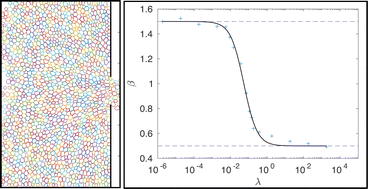Hopper flows of deformable particles
Abstract
Numerous experimental and computational studies show that continuous hopper flows of granular materials obey the Beverloo equation that relates the volume flow rate Q and the orifice width w: Q ∼ (w/σavg − k)β, where σavg is the average particle diameter, kσavg is an offset where Q ∼ 0, the power-law scaling exponent β = d − 1/2, and d is the spatial dimension. Recent studies of hopper flows of deformable particles in different background fluids suggest that the particle stiffness and dissipation mechanism can also strongly affect the power-law scaling exponent β. We carry out computational studies of hopper flows of deformable particles with both kinetic friction and background fluid dissipation in two and three dimensions. We show that the exponent β varies continuously with the ratio of the viscous drag to the kinetic friction coefficient, λ = ζ/μ. β = d − 1/2 in the λ → 0 limit and d − 3/2 in the λ → ∞ limit, with a midpoint λc that depends on the hopper opening angle θw. We also characterize the spatial structure of the flows and associate changes in spatial structure of the hopper flows to changes in the exponent β. The offset k increases with particle stiffness until k ∼ kmax in the hard-particle limit, where kmax ∼ 3.5 is larger for λ → ∞ compared to that for λ → 0. Finally, we show that the simulations of hopper flows of deformable particles in the λ → ∞ limit recapitulate the experimental results for quasi-2D hopper flows of oil droplets in water.



 Please wait while we load your content...
Please wait while we load your content...